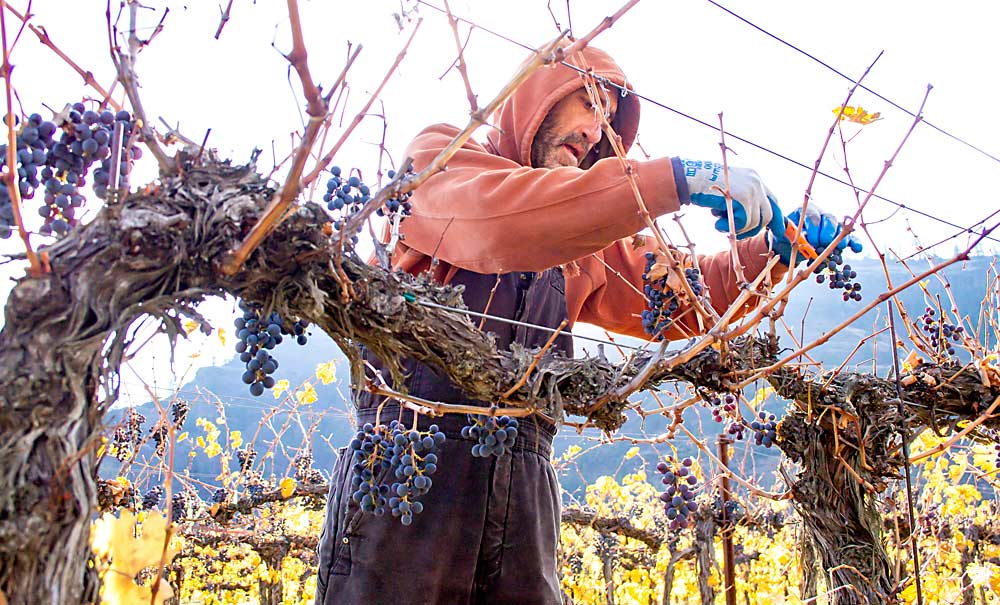
The diversity of vineyards in New York’s grape growing regions used to keep migrant farmworker crews busy. Today, though, skilled labor is in short supply, and while many of the region’s orchardists have turned to the expensive security of H-2A contracts, it’s still an uncommon move for grape growers.
The federal guest worker program is often seen as a no-go for smaller farms with fluctuating labor needs. However, grape growers could actually turn their diverse labor needs into an advantage again by sharing an H-2A contract with other growers in the area.
It’s an emerging idea that deserves consideration in the right circumstances, said Richard Stup, an agricultural workforce development specialist for Cornell Cooperative Extension. He wrote about it in a recent review of vineyard labor needs and potential solutions.
“H-2A is complex and it takes a certain amount of administrative capacity to participate in the program. That’s hard on smaller growers,” Stup told Good Fruit Grower. “But when farmers get together and share that H-2A workforce, say out of four growers, one member administers that HR function for the group. It recreates that role of the labor contractor, but with more control.”
The contracts, officially known as joint employer contracts, are not very common, said Kerry Scott, program manager for MasLabor, an H-2A contractor based in Virginia. They handle about a dozen every year, out of the hundreds of contracts they administer, he said.
Wine grape growers tend to be good candidates for such an arrangement because there’s a little more flexibility in the timing of labor needs, and that flexibility allows for more successful sharing, he said. For example, he just worked with a group of three vintners in Virginia, located at different elevations along the Blue Ridge Mountains. Thanks to the varied topography, “the ripening times are different enough that sharing is a piece of cake,” Scott said.
Few people know that joint contracts are an option. When growers say they are too small to use H-2A or they have gaps in their season, “I say, ‘Have you got any neighbors that would benefit from this program?’ and that’s when their light bulb goes off,” Scott said.
From a financial standpoint, sharing a contract means splitting the cost of working with a contractor such as MasLabor (Scott says they add $1,000 per additional employer to their basic fee, but sharing still provides a significant savings). Then, they can share the expenses of travel, housing and administrative work associated with the contract.
Typically, workers are assigned a base farm, maybe six at one vineyard and four at another, and then the growers split fees and expenses 60-40, Scott said. When more labor is needed all at once, they can combine crews, and each farm can pay the workers separately.
It’s up to growers to figure out how to share the workers, and Stup suggested that anyone interested in a joint contract should consider formal planning and a strategy for addressing conflict that may arise. After meeting with a group of grape growers who have shared an H-2A contract for several years, he said he was impressed by their organization and communication.
“You can imagine the communication challenges about how they are going to move the crew around and allocate things,” Stup said. “It would be very important to plan that schedule of labor needs to see that it does make sense and they aren’t going to have any severe pinch points where they don’t have the labor to meet the needs of both crops.”
It’s possible for growers to contract with neighbors who grow completely different crops as well. The diverse labor needs would be a plus, but the downside is that growers may not have established relationships with nearby producers in other crops.
“You could have a guy that’s a wine grape guy next to a tree fruit guy next to a guy that raises pumpkins for Halloween. There’s nothing that says those guys can’t enter into a joint relationship as long as we can detail a job description with the tasks for all those crops,” Scott said.
But it’s important to remember that an expansive job description written to meet the needs of several farms means that each of those tasks is now subject to H-2A regulations on all of the farms, Stup said.
The key to a good partnership is to consider it like a joint business venture, because of the joint liability in sharing the contract, Scott and Stup both stressed.
Sharing a labor force also puts growers at risk of running afoul of labor contractor laws, especially in Washington state where there are strict requirements and steep penalties. For example, growers who transport workers to a neighbor’s farm and get reimbursed for that cost can be considered labor contractors and face fines if they are not licensed.
“Anyone who is involved in any type of labor sharing needs to consult with a lawyer to see if they need to comply with Washington’s farm labor contractor act,” said Brendan Monahan, an employment attorney based in Yakima. There are so many specific land mines in these labor issues that he recommends legal counsel for anyone considering H-2A contracts, joint or not, and to ensure contractors carry state and federal licenses.
For most growers who can keep even a small crew busy throughout a season of at least six weeks, however, there’s no reason to add the complexity of sharing a contract, Scott said.
“It makes it even more necessary to have help from someone like us. There was a time when growers could do this paperwork themselves, but that has come and gone,” Scott said. Once arranged, however, growers tend to stick to their shared setup. “I’ve never had someone come back and say, ‘This isn’t working, I need to do this by myself.’” •
—by Kate Prengaman






Leave A Comment